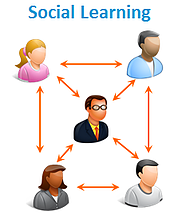 After reading this two-part series about social learning in the workplace, you will be well on your way to implementing employee training that is more efficient and effective. In the Social Learning in the Workplace Part 1, we clearly define social media and social learning in order to paint a better picture of how both can be utilized to enhance workplace training. In part 2 of this series we dig deeper to discuss the application, advantages and disadvantages of social learning. We will also explain some of the key barriers to gaining acceptance of organizational social learning technologies and provide approaches for increasing user adoption.
After reading this two-part series about social learning in the workplace, you will be well on your way to implementing employee training that is more efficient and effective. In the Social Learning in the Workplace Part 1, we clearly define social media and social learning in order to paint a better picture of how both can be utilized to enhance workplace training. In part 2 of this series we dig deeper to discuss the application, advantages and disadvantages of social learning. We will also explain some of the key barriers to gaining acceptance of organizational social learning technologies and provide approaches for increasing user adoption.
Social Media
Before we begin to understand the benefits of social learning, we must clearly understand what social media is. There are hundreds of definitions out there but all have at least three things in common.
- Social media enables social interaction among people so they can create, share or exchange information and ideas in virtual communities and networks.
- Social media utilizes internet connected applications build on the foundations of web 2.0 to allow the creation and exchange of user-generated content.
- As social media applications mature and advance, they will continue to become more interactive enabling users to interact and learn from one another in ways that exceed in-person learning.
Social learning

Social learning has similar repercussions as social media, but is focused on the physiological processes of humans, rather than the outcomes created by technology. Social learning involves interaction with others to make sense of information and ideas—it involves learning with and from others. It occurs naturally in our day to day lives when working in groups, socializing with friends, family and co-workers and even from watching TV.
The social learning theory proposed by Albert Bandura has become perhaps the most influential theory of learning and development. While rooted in many of the basic concepts of traditional learning theory, Bandura believes that direct reinforcement does not account for all types of learning. His theory adds a social element, arguing that people can learn new information and behaviors simply by watching other people. This is also known as observational learning (or modeling).
How can Social Learning Improve Workplace Learning?
 Workplace learning typically embodies an outside-in approach where a teacher or instructor provides the learner with content, information and ideas. Learning, on the other hand, entails an inside-out approach that is catalyzed with the learner’s desire to know--either a long-term desire or spontaneously from a recent event or interaction. Social learning then, relies on surrounding peers—it is not used to replace training but rather overlap; helping to enable knowledge transfer in a way that training cannot. It is important that current employees exude organizational values and behavior to ensure that new employees model exemplary behavior. It is also important that new hires have plenty of access to learning resources such us mature employees to provide expertise and past presentations and research to offer historical context. Finally, with a reliable social network intact, either online or offline, new hires will benefit from a forum of communicators and collaborators who can enhance workplace learning.
Workplace learning typically embodies an outside-in approach where a teacher or instructor provides the learner with content, information and ideas. Learning, on the other hand, entails an inside-out approach that is catalyzed with the learner’s desire to know--either a long-term desire or spontaneously from a recent event or interaction. Social learning then, relies on surrounding peers—it is not used to replace training but rather overlap; helping to enable knowledge transfer in a way that training cannot. It is important that current employees exude organizational values and behavior to ensure that new employees model exemplary behavior. It is also important that new hires have plenty of access to learning resources such us mature employees to provide expertise and past presentations and research to offer historical context. Finally, with a reliable social network intact, either online or offline, new hires will benefit from a forum of communicators and collaborators who can enhance workplace learning.




